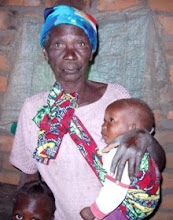
Friday, February 13, 2009
Monsoons in Indonesia
I have been working with the very very poor villages in East Bali where there is a tremendous problem with malnutrition. The woman you see here is suffering from goiters, which is a condition that comes from a lack of iodine. There is so little food here that the people eat cassava root which leaches the iodine from ones system. The baby here has pneumonia and also is suffering from what looked like scabies, a highly contagious condition that infests the skin. As there is no water in this area, basic hygiene is simply unheard of.
More on the developments soon.
Oh by the way, the baby will be going to the doctor this week, thanks to the donations we received from our supporters like you. Thank you so much for helping us make a difference in these peoples lives.
Blessings
Amana
Saturday, April 5, 2008
Monday, March 10, 2008
Widows Respond to HIV/AIDS Crisis | ||||
LUSAKA, Zambia, November 29, 2007— “Each time I saw other children go to school when mine were not, a lump of distress would come up my throat,” says Maiwase Mbewe as she hitches up and secures her ‘chitenje,’ or wrap-around cloth, in readiness to rejoin a group of other AIDS widows in a dance of celebration. The celebration dance of joy is part of a ceremony for a group visiting the Musanga Ward Community, a cluster of 120 villages with 1,225 households and a total population of 7,120. A six-hour drive from Lusaka, the capital city of Zambia, Musanga is a far flung remote border village, east of Chipata in the Eastern Province. It is home to the Madaliso Widows, Orphans and Vulnerable Children Community Support project. The widows and orphans are victims of an HIV/AIDS epidemic that has swept their community. Chipata district has an estimated population of 369,443 with an HIV prevalence rate of 26.3 percent, the highest in the province. The rate far exceeds the provincial average of 13 percent and the national average of 16 percent. Educating Those Orphaned by AIDS
“We began very small with very little money supporting 74 orphans with only 16 attending school,” Mbewe says of her group. “When word went around, more and more children came for support and for school. It was not long before our school was overwhelmed by the number of children.” Before long, according to Mbewe, the makeshift building started to fall apart. That’s when the Widows received $17,028 from the CRAIDS (Community Response to HIV and AIDS) component of the Zambia National Response to AIDS (ZANARA) project. The money was to support among other things;
“When we received support from CRAIDS our first priority was to build a decent school structure [that] you see standing there,” Maiwase says, pointing to a blue and white structure that has become the pride of the community. The widows now look after 572 orphans, 200 of whom attend school. And this year they have scored another victory. Thirteen orphans have graduated from their school and will enter Grade 8 in secondary education in government school. “This is a big achievement for us,” says Maiwase with a big smile. “With the gains in income we have made from our poultry project financed by CRAIDS, we are able to support the 13 orphans in secondary school. So you see, I have no lumps in my throat any more and today, when my tears roll down, they are tears of joy.” Reducing AIDS-related Deaths Although the rehabilitation of the school was the Widow’s first priority, the group is also well known for its work in the direct fight against HIV/AIDS. Misozi Phiri, a widow and one of the community project founding members, explains the achievements with a subdued smile and quiet demeanor.“Most of the chronically ill are no longer bedridden and now live productive lives,” she says. “Most of them have gone back to their villages to plough their fields. From a total of 247 chronically ill patients, half were bedridden; we now have only 10 patients on our register who are bedridden. But with the support from the community, they are getting better everyday and living positively.” The work of the group has been strengthened by the support provided by a government clinic a few kilometers away. The clinic advises on nutritional support through home-based care and the provision of Antiretrovirals. “Now we do not see many deaths in the community,” says Phiri. “We have been able to reach everyone in the community with HIV and AIDS information mainly through drama, and people talk about HIV and AIDS issues freely.” Both Phiri and Mbewe believe that CRAIDS’ support has not only empowered the Widows to openly talk about their own HIV status, but has also helped them promote income-generating activities as individuals and as a group. The members are now able to provide for the basic needs of their families. “Things have really changed for the better,” says Phiri. “Where as in the past we were marginalized as widows, we are now treated with dignity and respect as full members of this community.” And more importantly, Phiri says, the community has learned to support each other. “Stigmatization has tremendously reduced,” she says. | ||||




